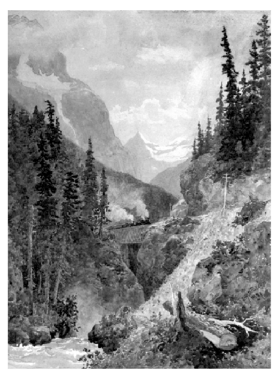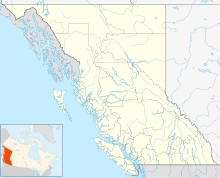Kicking Horse Pass facts for kids
Quick facts for kids Kicking Horse Pass |
|
|---|---|

1887 painting
|
|
| Elevation | 1,627 m (5,338 ft) |
| Traversed by | Trans-Canada Highway; Canadian Pacific Railway |
| Location | Banff National Park, Alberta / Yoho National Park, British Columbia, Canada |
| Range | Canadian Rockies |
| Coordinates | 51°27′10″N 116°17′00″W / 51.45278°N 116.28333°W |
| Official name | Kicking Horse Pass National Historic Site of Canada |
| Designated | 1971 |
Kicking Horse Pass is a famous mountain pass in the Canadian Rockies. It's located high up, at 1627 meters (5339 feet) above sea level. This pass sits right on the border between Alberta and British Columbia, Canada. It's also found within two beautiful places: Yoho National Park and Banff National Park.
Kicking Horse Pass is a National Historic Site. It's very important in Canadian history. The main railway line, called the Canadian Pacific Railway (CPR), was built through this pass in 1884. This route was chosen instead of another one further north.
Contents
Discovering Kicking Horse Pass
Europeans first explored this pass in 1858. This exploration was part of the Palliser Expedition, led by Captain John Palliser.
The pass and the nearby Kicking Horse River got their names from a funny event. James Hector, a scientist and doctor on the expedition, was exploring the area. While he was there, his horse kicked him! That's how the name "Kicking Horse" came to be.
The Challenging "Big Hill"
The original railway route for the CPR through the pass was very steep. It was known as "The Big Hill". This section went from Wapta Lake to Field, British Columbia.
The slope was 4.5 percent, which means it went up 4.5 meters for every 100 meters forward. This made it the steepest main railway line in North America. It was a huge challenge for trains!
Building the Spiral Tunnels
Because "The Big Hill" was so steep, trains often had accidents. Also, the railway needed extra helper engines to push trains up the slope. This made things very expensive.
To solve these problems, the CPR built a pair of Spiral Tunnels. These tunnels opened in 1909. They replaced the direct, steep route. The tunnels made the railway line longer by several kilometers. However, they made the slope much gentler, at 2.2 percent. This made it much safer and easier for trains to travel.
Even with the tunnels, accidents can still happen. In 2019, a major train derailment occurred. Sadly, three Canadian Pacific Railway employees lost their lives.
Modern Routes Through the Pass
The Trans-Canada Highway was built through Kicking Horse Pass in 1962. It mostly follows the same path as the original railway line. The highway reaches its highest point at Kicking Horse Pass, at an elevation of 1643 meters (5390 feet).
The Golden Triangle cycling route also goes through Kicking Horse Pass. It's a popular route for cyclists.
Divide Creek
Divide Creek is a special creek located at Kicking Horse Pass. What makes it unique is that it splits into two. One part flows towards the Pacific Ocean, and the other flows towards the Atlantic Ocean. This happens because it's right on the Continental Divide of the Americas.
Images for kids
-
Panorama of the tunnels from the west, 1908 The Big Hill on the Canadian Pacific Railway




